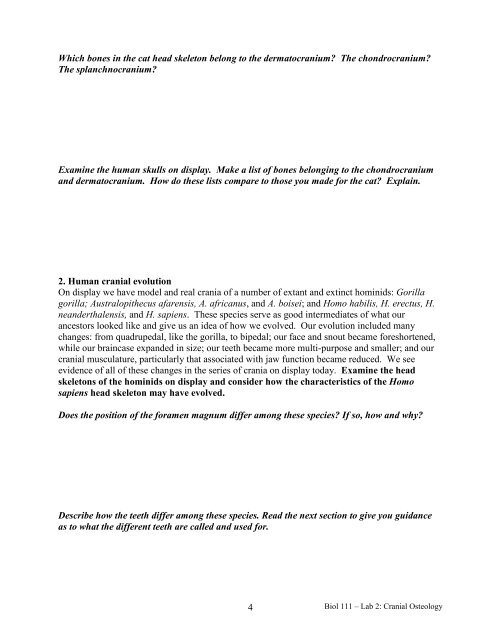Biol 111 – Comparative & Human Anatomy Lab 2: Cranial Osteology
Biol 111 – Comparative & Human Anatomy Lab 2: Cranial Osteology
Biol 111 – Comparative & Human Anatomy Lab 2: Cranial Osteology
Create successful ePaper yourself
Turn your PDF publications into a flip-book with our unique Google optimized e-Paper software.
Which bones in the cat head skeleton belong to the dermatocranium? The chondrocranium?<br />
The splanchnocranium?<br />
Examine the human skulls on display. Make a list of bones belonging to the chondrocranium<br />
and dermatocranium. How do these lists compare to those you made for the cat? Explain.<br />
2. <strong>Human</strong> cranial evolution<br />
On display we have model and real crania of a number of extant and extinct hominids: Gorilla<br />
gorilla; Australopithecus afarensis, A. africanus, and A. boisei; and Homo habilis, H. erectus, H.<br />
neanderthalensis, and H. sapiens. These species serve as good intermediates of what our<br />
ancestors looked like and give us an idea of how we evolved. Our evolution included many<br />
changes: from quadrupedal, like the gorilla, to bipedal; our face and snout became foreshortened,<br />
while our braincase expanded in size; our teeth became more multi-purpose and smaller; and our<br />
cranial musculature, particularly that associated with jaw function became reduced. We see<br />
evidence of all of these changes in the series of crania on display today. Examine the head<br />
skeletons of the hominids on display and consider how the characteristics of the Homo<br />
sapiens head skeleton may have evolved.<br />
Does the position of the foramen magnum differ among these species? If so, how and why?<br />
Describe how the teeth differ among these species. Read the next section to give you guidance<br />
as to what the different teeth are called and used for.<br />
4<br />
<strong>Biol</strong> <strong>111</strong> <strong>–</strong> <strong>Lab</strong> 2: <strong>Cranial</strong> <strong>Osteology</strong>
















